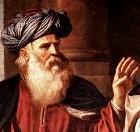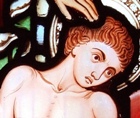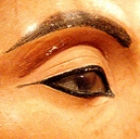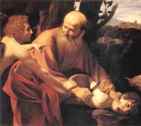Bible study activities
Movies about journeys
Stage 1: Make up a list
‘The Way Back’ is a journey film with strong religious symbolism. Watch out for the scene where Irena washes the bloody feet of Mr. Smith. Is Janis a Christ-figure? Do the travellers represent Jesus, his disciples, and Mary Magdalene? Washing in the stream may be a symbol of Baptism in the Jordan. What about the Crown of Thorns that each traveller wears? As they look after each other (the Christian ideal), even the criminal stops doing evil.
It is no accident that, throughout most of Abraham’s story, he is travelling along an uncharted path. The Bible makes it clear that his life is essentially a journey towards God.
Many of the films made today, particularly journey films, have embedded religious symbolism – a ‘message’ woven into the story of the hero/heroine as they travel towards their goal.
List some films that use religious symbols. You can choose recent films or classics. If this is a group activity, choose films most people know.
Stage 2: Choose your favourite
1. What are the central messages in this film?
2. Do any of the scenes remind you of your own life experiences?
Stage 3: Think about your choices
- Group activity: discuss the symbols and their meanings, making sure everyone in the group has a chance to talk about their ideas.
- Single activity: choose the film that caught your attention most of all. Sit down for a few minutes and focus your mind. What was it about this film that particularly appealed to you? What did it mean to you? Why was this so?
Movies about journeys and endurance
Can you name the films?
Can you see a connection with Abraham’s story?
Answers HERE (see ‘Abraham’) Can you think of others?
Paintings of Abraham
ABRAHAM: PAINTINGS has 27 famous paintings of events in Abraham’s life
Stage 1
Read the story at Bible People: Abraham
Stage 2
Go to the link Abraham: Paintings. Scroll through the paintings from first to last.
Which part of the story of Abraham has been the most popular with artists?
Would this have been your choice?
Artists paint what they want to paint, but they also paint with their audience in mind. Look at the paintings again. Who is the painting directed at? Explain your reasoning.
Stage 3
If you have chosen something different, ask yourself why this other incident appeals to you more than the scene favoured by the artists. Spend some time quietly thinking about your response.
Is there one particular characteristic of Abraham’s that you admire? What might it be? How might you imitate it in your own life? Do you have a particular characteristic that you are proud of? What is it?
Poetry about Abraham and Isaac
The Sacrifice of Isaac by Scott Cairns
Who among us could bear the memory of
Abraham’s knife as it entered the heart of his
son? Few enough, presumably. For why else has
that incommensurate tableau been misre-
peated so thoroughly?
In the stillness of that hour, the Lord pressed
his servant inexplicably far and despite the
gentled features of a great many fables there-
after—the angel’s intercession, the convenient
goat, et cetera—the knife did find its cramping
sheath there in the boys bared breast, and
blood covered both the boy and the father who
embraced him even then, and blood coloured
the rock altar, roughed the more underfoot.
In pity, then, the Lord briefly withheld time’s
aberrant fall, retracted the merest portion of
its descent, sparked a subsequent visitation of
the scene. This time, he stayed the hand, the
knife, the rush of blood and of horror, but only
in time.
Just outside time’s arch embarrassment—in
the spinning swoon of the I Am—the boy is
bloodied still upon the rock, the man fallen
upon him, left with nothing but his extreme,
his absolute, his dire obedience.
Talking To God
- ‘I will make you a great nation…’ Genesis 12:2
- ‘Why did Sarah laugh? Is anything too wonderful for the Lord?’ 18:13-14
- ‘But the angel of the Lord called to him from heaven, and said “Abraham, Abraham!” And he said “Here I am.” 22:11
These three quotations show the dynamic nature of the relationship between Abraham and God (or the angel who is God’s messenger).
Each speaks as if they are face-to-face with each other, talking at a conversational level.
- How do you speak when you are praying/talking to God?
- Do you use a formal prayer, or do you speak/argue/implore/thank at a more personal level?
- What works for you?
- Discuss different ways of praying with a Bible study partner.
Pause for Thought
Someone wrote that we’re all Abraham, and we’re all Isaac.
What might they have meant by this?
Abraham’s Family – and Yours
Read the story of the command to sacrifice Isaac (Genesis 22).
- Who is involved?
- What does this tell you about the dynamics of a nomadic tribe, and of Abraham’s own family in particular?
- What are the dynamics within your own family?
- Are you satisfied with them?
- Would you like change to happen?
- How might that be achieved?
Draw up a list of things that YOU could do.
Focus Questions
1. What are the most interesting moments in Abraham’s story ? (You can read the Bible text of the story, or the modern re-telling)
Old Man and Baby, Jozef Israels
2. In the story, who speaks and who listens? Who acts? Who gets what they want? If you were in the story, which person would you want to be friends with? Which person would you want to avoid?
3. What is God’s interaction with the main characters? What does this tell you about the narrator’s image of God? Do you agree with this image?
4. What is happening on either side of the story, in the chapters before and after it? Does this help you understand what is happening?
5. The narrator/editor has chosen to tell some things and leave other things out. What has been left out of the story that you would like to know?
6. Are the characteristics and actions of the people in the story still present in the world? How is the story relevant to modern life, especially your own?
Search Box
![]()
© Copyright 2006
Elizabeth Fletcher







